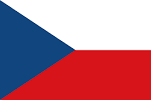
 Training Around the World
Training Around the World
Orthopaedic Training in the Czech Republic
Prague, Czech Republic
The Czech Republic is well-known for its beautiful cities, tourist attractions or spa treatments. Prague, the capital, is an old beautiful city which was bombed by the Germans, occupied by the Russians and under the communist regime until 1989. In 1993, then Czechoslovakia was divided into two sovereign states, the Czech and Slovak republics, and joined the European Union in 2004.
However, orthopaedic training in the Czech Republic may not be as well-known as Prague.
As a Czech or Slovak citizen, you have to complete secondary school and pass the final exam in the Czech (or Slovak) language. Then, you need to pass the entrance exam for the medical faculty where each faculty has its own entrance exams. However, a foreigner has to enroll in the General Medicine (Dentistry) study programs which are taught in English. These programs are offered by almost all of the medical faculties in the Czech Republic. Each faculty has various requirements for admission. Some do require proof of English language proficiency, while some do not. However, secondary education is a must. The candidate then has to pass the entrance exam which varies between the faculties.
You then need to undergo 6 years of undergraduate training, where students have 3 years of theoretical (preclinical) and 3 years of clinical training under complete supervision. During the course, the Czech language is taught, so that during those 3 clinical years even English students are able to communicate with Czech patients in the hospital. Final examinations in the 6th year consist of 4 “state exams” namely internal (general) medicine, paediatrics, surgery and obstetrics-gynaecology. After passing these, the graduate has the right to use his MUDr. degree which is written in front of his name and stands for Latin “Medicinae Universae Doctor”.
You can then decide on your specialty. Since 2004 a new system has been introduced and developed to catch up with the rest of Europe. You will have a chance in the first two years to get a flavour of internal medicine, anaesthesiology and general surgery, where you will spend 8 weeks in each and learn the basics. After the two years, you will take a written exam in your chosen specialty, which will then allow you to proceed further in that specialty.
The certificate of completion ("Attestation") in orthopaedics in the Czech Republic will be awarded after working as an orthopaedic trainee for 48 months where one spends most of one's training in orthopaedics with short internships in other specialties, such as neurosurgery, neurology, and others. During this period of time the orthopaedics trainee has to perform various types of surgery such as trauma, hip replacements, knee replacements and basic elective surgeries. In the Czech Republic, the training system believes that practice is the mother of teaching. Therefore, the training program does not include specific courses like AO principles of fracture management, and so on. Upon completion of training, one will need to sit the "Attestation" exam which has two parts – theoretical and practical.
Part of the training is only provided by certain types of hospitals. For the purpose of the training in specialties, Czech hospitals are divided into 3 groups, where only group III accredited hospitals (almost only university hospitals) are eligible to provide complete training in orthopaedics. Trainees being trained in smaller or regional hospitals with a lower level of accreditation will have to spend a certain part of their training in level III accredited hospitals for completion of their training. The training in orthopaedics lasts at least 6 years and the trainee is able to do research as well as a PhD as part of the training.
In the Czech Republic orthopaedics is divided into a number of specialties such as Orthopaedics & Traumatology of the musculoskeletal system and general traumatology. Spinal surgery is only available as a subspecialty for which you first have to get the certificate of completion in orthopaedics, neurosurgery or traumatology.
The doctor, regardless of his level of training, has his/her own clinic and patients, where he/she will make decisions on the best treatment for the patient. All patients scheduled for any type of surgery are to be discussed in the morning meeting where the professor (head of the department) will take part in the decision and either he will agree or not. On that basis, the surgery will proceed and the doctor who sees the patient initially in the clinic will perform the procedure unless the procedure is beyond his/her skills, then the professor or other senior doctors will get involved.
According to many young doctors, the training system is still in a transitional period and there is a significant uncertainty due to a constant changing of the training programme. Having said that, the training system is still very accessible and has its strengths and weaknesses. The system works for this country and the certificate of completion of training is accepted in all of Europe.

















